The cases of road accidents have gone up as the number of vehicles increased multifold. Overspeeding and traveling without necessary documents is a common sight now.
And to deal with this, traffic cops have to do vehicle verification every now and then. Yet, the process is not devoid of challenges.
Firstly, stopping a driver and verifying each document manually is a tedious task. It consumes a lot of time and effort.
Secondly, it is difficult to determine the authenticity of the documents. The driver may show a fake or duplicate document and get cleared. The whole process to validate the genuineness of traffic documents is a taxing job.
Thirdly, with the thefts going up, it’s becoming quite difficult to track the stolen vehicles.
So, it’s time to make the vehicle verification process more quick and efficient. And one of the solutions is to use QR Code technology.
Today, QR Codes are being used worldwide across various industries. These include aviation, chemicals, sports, product packaging, and transportation.
Keep reading to know how they can make the process of vehicle verification better.
A. What are QR Codes—a brief
QR Codes are 2D barcodes, which are easy to use and create. They can link unlimited information. Hence, you can encode the driver’s information with ease.
Plus, there is no need to spend on a handheld scanner to scan the QR Code. You can easily scan them using a smartphone camera.
Lastly, they occupy very little space. The data is encoded in the data modules of a QR Code. Hence, they do not expand vertically but only become denser as more data is encoded.
So, QR Code technology can help improve the process of vehicle verification. In the succeeding sections, will show you how it works.
B. Why use QR Code for vehicle verification
Many techniques are used today to verify traffic documents. One is the traditional method. Here, a driver shows their documents to the responsible personnel. For example, driving license and insurance.
This is generally done by stopping the driver either on the road or at the toll booth. But it consumes a lot of time for both the driver and the traffic personnel. Moreover, the driver also has to give a fine if they misplace or lose their documents.

Other hi-tech methods include smartcard-based license management and iris scanning approach. But these methods are very expensive and incur a high installation cost.
QR Codes in vehicle verification aims at reducing traffic police work. They are not capital intensive and hence will prove to be a cost-effective solution. Besides being a sustainable solution, they help in resolving all the above-mentioned challenges.
Let’s move ahead to see how.
C. How does a QR Code work for vehicle verification
QR Codes are generally used to encode information. And people can scan these QR Codes via their smartphones to decode the information.
To enhance the verification process, you can add important information to the QR Code. These may include the driver’s contact details and their registration certificate.

Now, the driver just needs to carry this QR Code in their smartphone. When asked for vehicle verification, they can simply show this QR Code to traffic police. The latter will then scan the QR Code and send it to RTO. Once the RTO verifies the driver information automatically, the traffic police can give a green signal to the driver to continue their journey.
That’s it. This has many other benefits, which we will discuss in the next section.
D. Benefits of using QR Codes
Here is how QR Codes can resolve challenges:
1. Quick way of vehicle verification
The traffic police personnel just need to scan the QR Code and get all of the driver information. Since it takes just a few seconds to perform a scan, the verification would only take a few seconds.
Plus, the probability of negligence in the manual document verification would also be eliminated.
2. Documents will always remain intact
With QR Codes, the drivers will not have to worry about anything. They can rest assured despite misplacing, losing, or forgetting the documents. They just need to present the QR Code saved in their smartphone for vehicle verification.
3. Checking becomes more authentic
It is nearly impossible to bypass the verification step facilitated by a QR Code. Hence, the traffic police will be able to authenticate driver’s identity with ease.
4. Quick Vehicle management system
With QR Codes, manufacturers/retailers can easily manage vehicle registration and distribution. It helps to streamline the whole supply chain process.
In addition to this, customers can scan it to verify whether it is authentic or stolen.
5. Easily track stolen vehicle
QR Codes can help detect stolen vehicles. The user/retailer simply needs to create a new registration. And generate a QR Code for the vehicle information. As the police scan, the system will pop an alert message if there is any complaint registered against the vehicle.
Thus, the system will facilitate automatic recognition by scanning the QR Code.
The owner or retailer will not be asked any additional questions. Neither do they have to carry a hard copy of the documents. This way, the whole process will become smoother.
For more information, you can refer to this detailed guide.
Hence, you now know how QR Codes can optimize the process of vehicle verification. The best part is that some countries are already using this technology. We will give some examples in the next section.
E. Some use cases
See how countries are making the process of vehicle verification more authentic:
1. Spain
The General Directorate of Traffic, Spain has launched miDGT application. This is a QR Code-based application. It allows drivers to carry their vehicle documents on their mobile. For example, driving license and registration information.
The traffic police personnel can verify driver details in real time by scanning the QR Code from the tablets, which they carry.
2. India
Banglore, a city in India is using QR Codes on auto-rickshaws. The aim is to make the passenger feel secured and to make the vehicle verification process quick. Upon scanning this QR Code, one can get driver’s details. The passengers can also send them to their family and friends.
Besides, by scanning the QR Code, traffic police personnel can know if the vehicle is involved in a crime.
In addition to this, the Government of India has also introduced mParivahan QR Code. Drivers can download the mParivahan app. And fill in the details such as the last four digits of vehicle’s chassis number and engine number to get virtual RC. Once finished, click on My RC on the dashboard to view your own QR Code. Police personnel can scan this QR Code to verify all the details.
Now, let’s move ahead to show how you can create QR Codes.
F. How to create QR Codes
You can create QR Codes for vehicle verification in two ways. These are:
a. Generate QR Codes in bulk
Using QR Batch to demonstrate how to generate QR Codes in bulk:
1. Create an account on QR Batch
2. Now, choose the QR batch type from the following options—Generate QR Code Images or Generate QR Code Labels
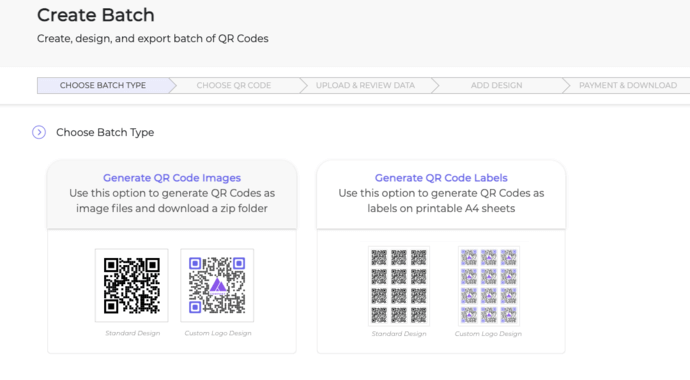
Generate QR Code Images option allows you to download your QR Codes as images.
On the other hand, Generate QR Code Labels option allows you to generate QR Codes as labels on printable A4 sheets and via the dashboard, choose Plain Text or Website URL QR Code for your use case
3. Now, choose Plain Text or Website URL QR Code for your use case
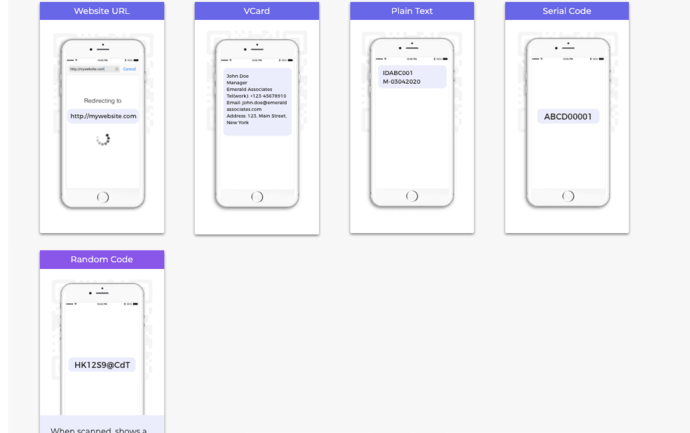
4. Create the spreadsheet in CSV, XLS, and XLSX format. For more information on how to create a spreadsheet, you can refer to this detailed guide
Upload file
5. Now click on Upload File and upload the spreadsheet that you’ve created
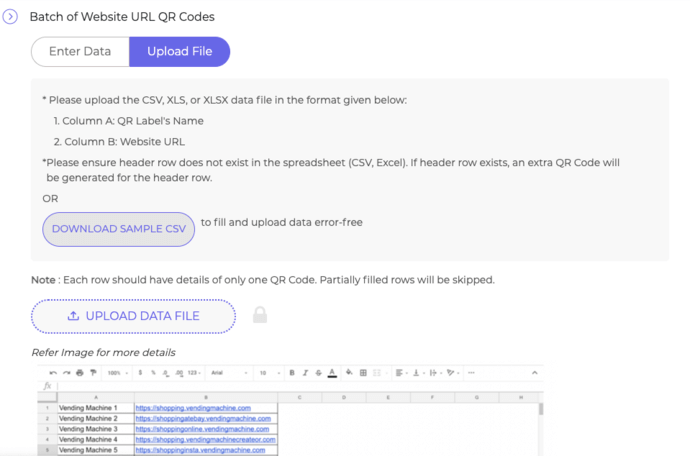
6. Next, click Review Data. Here, match and confirm the column name from the drop-down menu by clicking on against every matched column

Choose the design
7. Now you’ll see three design options to choose from- Standard design, Custom Logo design, and Custom Background design
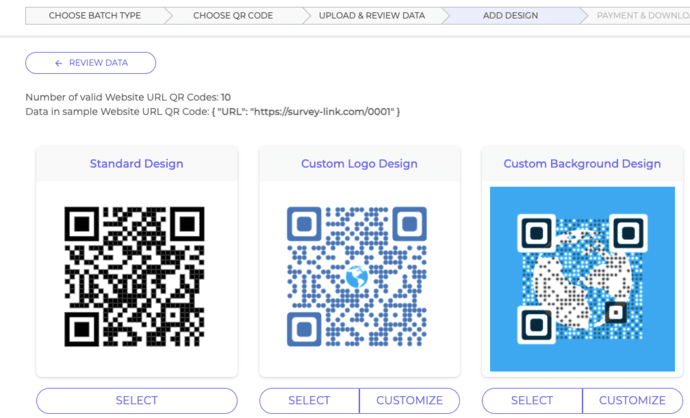
8. Once you’ve finalized the design, click Select. A window will pop up. Here, choose the option of QR Code image and specify image size and format
If you selected Generate QR Code Images as batch type in the beginning, you’ll see the following options—PNG, JPG, SVG, EPS, and PDF. On the other hand, if you selected Generate QR Code labels option, you’ll see the options to name the batch, and choose the label sheet layout.
9. Review all specifications. If all looks fine, proceed to payment and your QR Code batch will start processing
10. Once finished, you will receive an email containing a zip folder of QR Code files. Alternatively, you can also download your QR Codes from the My Batches dashboard
That’s it. Your QR Codes are ready.
b. Generate QR Codes via API
You can also integrate your registration system with the QR Code generation. This will allow you to generate QR Codes in real-time.
You can do this by using a professional API tool such as Scanova’s API.
All you need to do is— just send a GET request with data (QR Code design, size, format, and the data to be saved in it) to Scanova’s API. The API will then respond with the QR Code image.
For more information, you can go through this detailed guide on QR Code API.
Likewise, you can also use Scanova’s SDK and add it to your own server. Here, you can make API calls locally. This allows you to generate custom-designed QR Codes at a must faster rate.
Hence, this is all you need to know about QR Codes for vehicle verification. By now, you know how QR Codes can make the process more fast and authentic.
Create QR Codes to Verify Vehicles


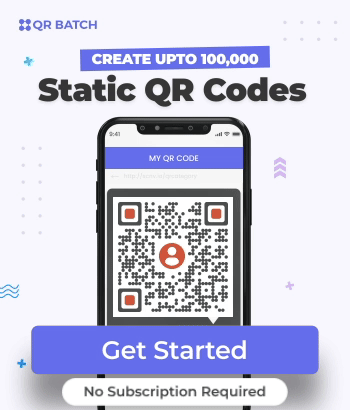
I am regular visitor, how are you everybody?
This piece of writing posted at this site is truly fastidious.